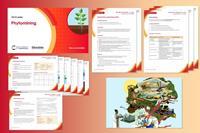Introduce aspiring chemists to a more sustainable way of extracting valuable metals that also offers an environmentally friendly solution to cleaning up contaminated land.
This resource accompanies the Education in Chemistry article The magic money tree?
Learning objectives:
- Use key words associated with phytomining.
- Sequence the processes involved in phytomining.
- State an advantage and disadvantage of phytomining.
- Describe how plants can be used to extract metals from low grade ores.
-

Download this
Cloze worksheet, for age range 14-16
Download the printable student worksheet as MS Word or pdf or the interactive worksheet as MS Word.
Sequencing worksheet, for age range 14-16
Download the differentiated student activity as MS Word or pdf.
Storyboard worksheet, for age range 14-16
Download the student worksheet with a variety of differentiation options as MS Word or pdf format.
Teacher resources
Download the lesson presentation as MS Powerpoint and the teacher notes, including answers to all of the student activities, as MS Word or pdf.
Introduction
In today’s high-tech society, there is an increasing need for valuable metals to use in computers and mobile phones. Learners need to be able to describe the process of phytomining and understand how plants can be used to extract metal from low grade ores.
Differentiated activities
This set of resources includes teacher presentation and three differentiated activities for use with 14-16 year old learners:
| Resource | Description | LOs met |
|---|---|---|
| Powerpoint presentation | A resource for the teacher to deliver the relevant information describing phytomining. | N/A |
| Cloze activity | Learners use key words to complete sentences to describe phytomining. This activity is available as both a printable worksheet and an interactive worksheet. | Learners will meet learning objective 1 and partially meet learning objectives 3 and 4. |
| Sequencing activity | Learners rearrange the sentences to describe the process of phytomining. There are two levels of differentiation available. | Learners will meet learning objective 2 and partially meet learning objectives 3 and 4. |
| Storyboard activity | Learners create a storyboard using images and text to describe the process of phytomining. Teachers can provide different combinations of the worksheet and support sheet to offer a range of differentiation options. | Learners will meet, or partially meet depending on the differentiation option provided, all of the learning objectives. |
More resources
- Help learners to understand the physical and chemical processes that occur in plants, and how these relate to a plant’s structure and functions with this series of plant science practicals.
- Explore the potential of phytomanagement in more detail with this challenging plants resource.
- Discover how chemists are turning to plants to help solve the plastic problem with products from biomass.
- Weigh up the environmental impact of lithium mining in Cornwall as we look to lithium-ion batteries as an alternative to fossil fuels in our cars.
- Find out how Emma’s role as a bioleaching lab technician uses a different metal extraction technique to collect and process precious metals collected from electronic waste products.
Downloads
Phytomining 14–16 years PPT
Presentation | PowerPoint, Size 1.27 mbPhytomining student cloze interactive
Word, Size 0.44 mbPhytomining student cloze (printable)
Handout | PDF, Size 0.12 mbPhytomining student sequencing activity
Handout | PDF, Size 0.12 mbPhytomining student storyboard
Handout | PDF, Size 0.32 mbPhytomining teacher notes
PDF, Size 0.25 mbPhytomining student cloze (printable)
Editable handout | Word, Size 0.45 mbPhytomining student sequencing activity
Editable handout | Word, Size 0.43 mbPhytomining student storyboard
Editable handout | Word, Size 0.77 mbPhytomining teacher notes
Word, Size 0.54 mb


















No comments yet